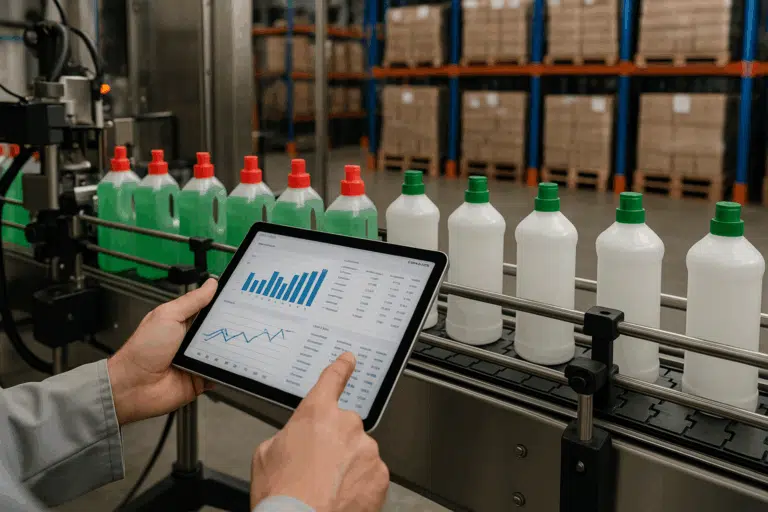A RFID asset tracking solution involves RFID smart tags and labels, fixed or handheld RFID readers, and custom software solutions to suit any asset management or inventory management needs. Not only can RFID tags be read in bulk when tagged to inventory products, but these can also be without the need of sight. Speeding up the inventory cycle counts with high data accuracy, while preventing manual errors – that are common when using QR codes or barcodes. Below presents a couple of ways the RFID asset tracking solution can help with IAS 16 compliance:
- Automated tracking – RFID technology allows for automated tracking of inventory, which makes it easier to keep accurate and up-to-date records of property, plant, and equipment. This can ensure regulatory compliance with IAS 16 by providing accurate data on assets and their movements.
- Real-time data – RFID tags can provide real-time data on inventory, which is useful for compliance with IAS 16. This information can help companies accurately measure and recognize assets in their financial statements.
- Increased visibility – RFID inventory solutions can provide increased visibility into inventory, including assets. This can help companies understand the nature of their assets and the risks and rewards associated with them, which is important for compliance with IAS 16.
- Reduced errors – RFID inventory solutions can reduce errors in tracking inventory, which can help ensure compliance with IAS 16. Automated tracking and real-time data can help minimize the risk of errors, which can lead to inaccuracies in financial statements. Better control over assets – RFID inventory solutions can provide better control over assets, which can help ensure compliance with IAS 16.
- Real-time data can help companies understand when assets are being used, where they are located, and how they are being used, which can be useful in determining their value.
Overall, an RFID asset tracking solution can help companies to comply with IAS 16 by providing accurate and up-to-date information on assets, reducing errors in tracking inventory, and increasing visibility and control over assets
What’s the IAS 16 Compliance?
IAS 16, Property, Plant and Equipment, is an International Financial Reporting Standard (IFRS) issued by the International Accounting Standards Board (IASB) that sets out the principles for the recognition, measurement, presentation, and disclosure of property, plant and equipment (PPE) in financial statements. It applies to all entities that have PPE, including land, buildings, machinery, vehicles, and other tangible assets that are held for use in the production or supply of goods or services, for rental to others, or for administrative purposes. The standard provides guidance on when to recognize an asset, how to measure its cost, and how to depreciate it over time. Compliance with IAS 16 means that an entity’s financial statements accurately reflect the nature, cost, and depreciation of its PPE, in accordance with the principles set out in the standard. This includes proper recognition of assets, accurate measurement of their cost, and appropriate depreciation methods. Additionally, IAS 16 requires companies to disclose information about their PPE in their financial statements, such as the total carrying amount, any impairment losses, and the methods used to depreciate the assets. In summary, IAS 16 compliance is the adherence to the international accounting standards that govern the recognition, measurement, presentation, and disclosure of property, plant, and equipment in financial statements.
What are the key concepts of IAS 16 Property, Plant and Equipment?
Below presents a some of the key concepts of IAS 16, Property, Plant and Equipment, include:
- Recognition of PPE – An asset should be recognized when it is probable that future economic benefits will flow to the entity and the cost of the asset can be measured reliably. This means that the asset must be expected to generate future economic benefits and the cost of the asset must be known or estimable.
- Measurement of PPE – The cost of an asset is the amount of expenditure incurred to acquire or construct the asset, including any directly attributable cost of bringing the asset to the location and condition necessary for it to be capable of operating in the manner intended by management. This cost is then recognized as an asset in the statement of financial position.
- Depreciation of PPE – The entity should use the straight-line method of depreciation for PPE, unless another systematic basis is more representative of the expected pattern of economic benefits from the use of the asset. Depreciation is the process of allocating the cost of an asset over its useful life. It is the systematic allocation of the depreciable amount of an asset over its useful life.
- Revaluation of PPE – An entity may revalue its property, plant, and equipment, and the revaluation should be made at least every five years. Revaluation is the process of re-measuring an asset at fair value. It is an optional method of accounting for PPE.
- Impairment of PPE – An asset’s carrying amount should be reviewed at each reporting date to determine whether there is any indication that it is impaired. If any such indication exists, the asset’s recoverable amount should be estimated. Impairment is the process of recognizing that an asset’s carrying amount is more than its recoverable amount.
- Disclosure of PPE – An entity should disclose information that enables users of its financial statements to evaluate the nature, timing, and uncertainty of the entity’s future cash flows arising from its property, plant and equipment. This includes information about the carrying amount, depreciation, impairment, revaluation and expected future cash flows from the assets.
- Property held for sale – Property, plant and equipment that is classified as held for sale should be measured at the lower of its carrying amount and fair value less costs to sell. This is an accounting treatment for an asset that is intended to be sold in the near future.
In summary, IAS 16 provides guidance on the accounting treatment of property, plant and equipment, it requires that an asset should be recognized when it is probable that future economic benefits will flow to the entity, cost of the asset can be measured reliably, Depreciation should be done using straight-line method, Impairment should be reviewed at each reporting date, and the entity should provide disclosures that enable users of its financial statements to evaluate the nature, timing, and uncertainty of the entity’s future cash flows arising from its property, plant and equipment
Improve your financial reporting with CPCON’s RFID asset tracking solution
By understanding the fixed asset internal controls required by IFRS IAS compliance, companies can ensure that their fixed assets are properly managed and accounted for. It is also important to note that some of these controls may differ depending on company size and industry. Companies should always consult with a qualified accountant or financial advisor when setting up these controls to make sure they adhere to all necessary regulations.
Are you ready to keep track of your fixed assets and internal controls through an automated tracking solution? Contact CPCON today to learn more about how fixed asset management solutions can help you improve your business.



























